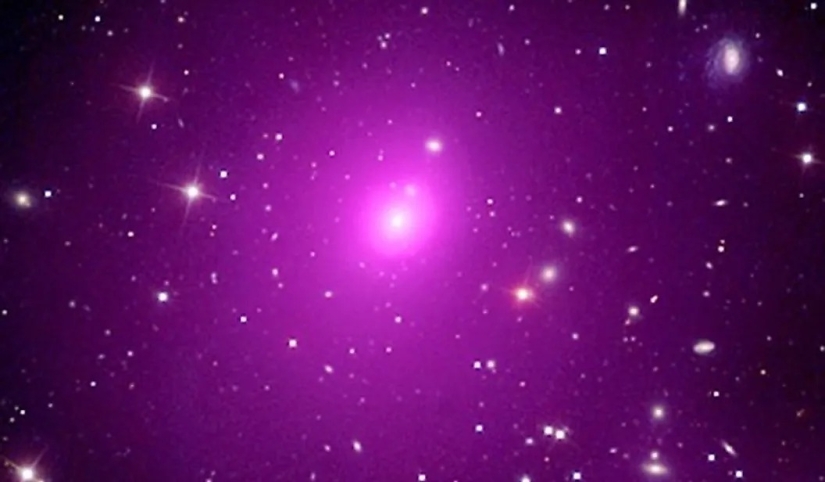Los 5 agujeros negros más masivos descubiertos hasta ahora en el universo
Categorias: Aerofoto | Cósmico | Mundo | Tecnología
Por Vika https://pictolic.com/es/article/los-5-agujeros-negros-ms-masivos-descubiertos-hasta-ahora-en-el-universo.htmlLos agujeros negros se encuentran entre los objetos más masivos conocidos del universo. Son tan masivos que su atracción gravitacional excede la velocidad de la luz. La luz, el objeto más rápido conocido en el universo, no puede escapar de la gravedad de un agujero negro. Si bien todos los agujeros negros son masivos, algunos son mucho más masivos que otros. Los agujeros negros más grandes, denominados agujeros negros supermasivos, generalmente existen dentro de los núcleos de galaxias masivas. ¿Cuáles son los cinco agujeros negros más masivos jamás descubiertos?
5 FOTOS

1. Phoenix A Black Hole
Phoenix Cluster.
To date, the most massive black hole ever discovered is in the Phoenix Cluster, a large cluster of multiple galaxies. The black hole itself is in the central galaxy of the cluster. While the exact mass of the black hole is not known, estimates place its mass at around 100 billion suns. This black hole is more massive than even some larger galaxies, and it is over 24,000 times the mass of the supermassive black hole at the center of the Milky Way. The diameter of the black hole is an estimated 366.9 billion miles (590.5 billion kilometers), making it over 100 times larger than the distance between the sun and Pluto.

2. TON 618
TON 618. Image credit Sloan Digital Sky Survey, Apache Point Observatory, Astrophysical Research Consortium via Wikimedia Commons
TON 618 is a supermassive black located just over 10 billion light years away. With a mass of 66 billion suns, it is one of the most massive black holes ever found in the universe. TON 618 was first observed in 1957, yet at the time, scientists had no idea what it was. TON 618 is currently producing what is known as a quasar: massive beams of high energy radiation emitted by supermassive black holes. The existence of quasars was unknown prior to 1963, and so when TON 618 was first discovered, scientists were unaware that it was a supermassive black hole. The quasar itself is one of the brightest known objects in the universe, being over 140 trillion times brighter than the sun. The quasar is so bright that scientists cannot observe the galaxy containing TON 618.

3. Holmberg 15A
Holmberg 15A.
Holmberg 15A is a massive elliptical galaxy located some 700 million light years away. At the core of this galaxy is one of the most massive black holes ever found, having a mass of around 40 billion suns. Scientists believe that the black hole at the core of Holmberg 15A grew to its current size by merging with countless other black holes, allowing it to increase its mass over time.

4. IC 1101
IC 1101 is a supergiant elliptical galaxy and the largest known galaxy in the universe. At its core, is one of the most massive black holes ever found. The galaxy itself has an estimated diameter of 6 million light years and is 1.1 billion light years away. The central black hole of IC 1101 has an estimated mass of around 40 billion suns and is currently producing vast amounts of high energy radiation that move outwards from the black hole as beams of light.

5. S5 0014+81
S5 0014+81.
S5 0014+81 is a supermassive black hole with a mass of around 40 billion suns. In addition to being one of the most massive known black holes, it is also producing a quasar that has a brightness of 300 trillion suns, making it one of the brightest known objects in the universe. It is almost 25,000 times brighter than our entire galaxy. S5 0014+81 has an estimated diameter of 149 billion miles (240 billion kilometers), making it 40 times larger than Pluto’s orbit. S5 0014+81 is one of the oldest black holes ever found, having formed less than 2 billion years after the Big Bang, which suggests that supermassive black holes played an important role in the formation and evolution of early galaxies.
Palabras clave: Agujeros negros | Universo | Galaxia | Espacio | Vía Láctea | Planetas | Agujeros negros supermasivos | Gravedad | Galaxias masivas
Publicar artículo de noticiasArtículos Recientes

La ballena azul, o bluewalker, es el animal más grande que actualmente vive en la tierra. Algunos individuos alcanzan una longitud ...

En el cine moderno, no hay ningún lugar sin efectos especiales. Le presentamos fantásticos ejemplos de superposición de efectos ...
Artículos relacionados

La vida de las personas en otros planetas ya no parece una fantasía perfecta, como hace unas décadas. La exploración espacial se ...

La cuestión de cómo huele el espacio puede no ser considerada de actualidad, pero, debe estar de acuerdo, sería interesante ...

La astrofotografía hace visible lo invisible al ojo y revela la belleza del cielo nocturno. Capturo la luz que viaja a través del ...

Incluso los genios matemáticos no son ajenos a las simples alegrías humanas. También quieren vestirse bellamente, conducir autos ...